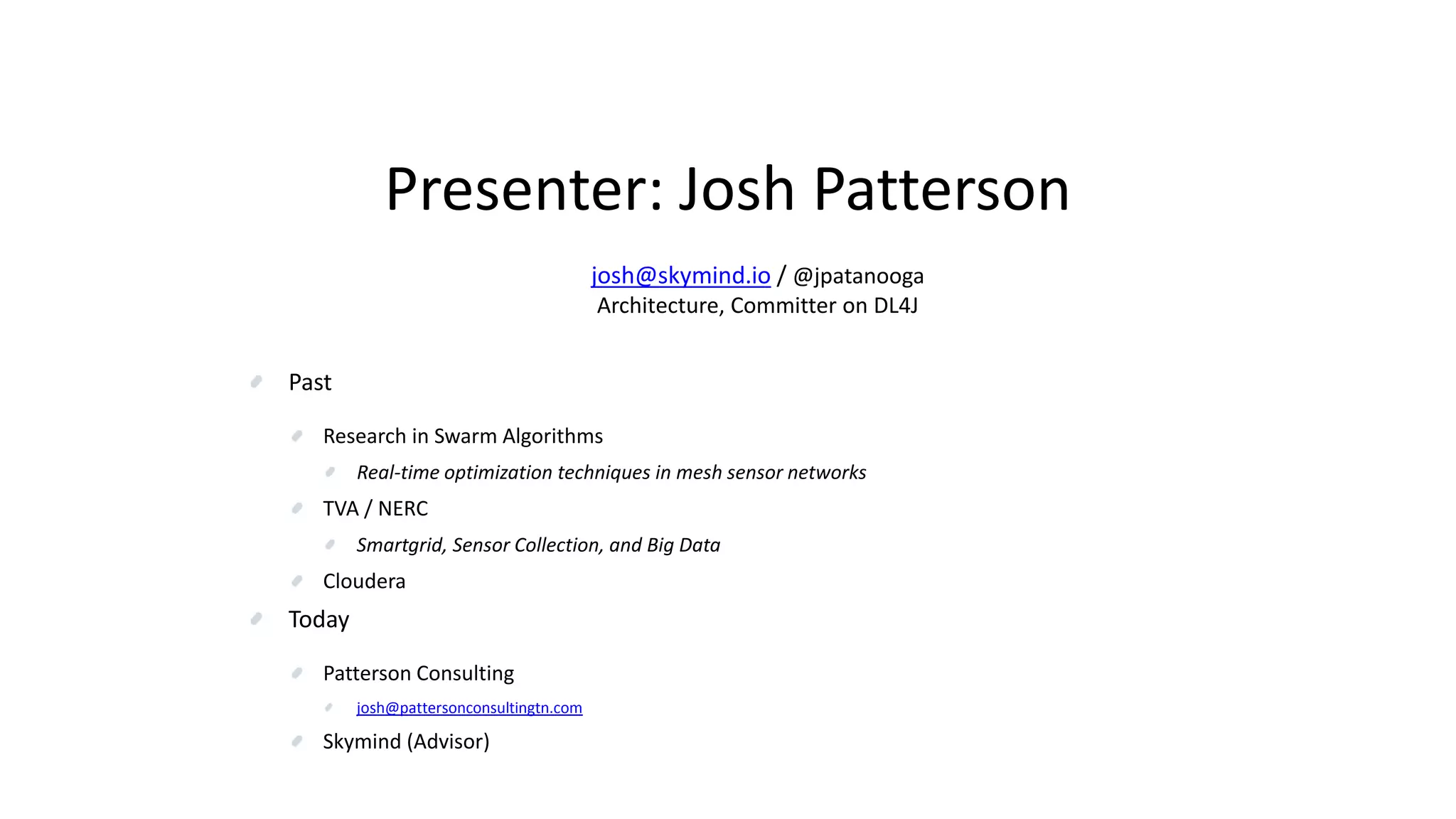This document discusses deep learning and DL4J. It begins with an overview of deep learning, describing it as automated feature engineering through chained techniques like restricted Boltzmann machines. It then introduces DL4J, describing it as an enterprise-grade deep learning library for Java, Scala, and Python that supports parallelization on YARN and Spark as well as GPUs. The rest of the document discusses using DL4J with Spark for deep learning workflows on large datasets and provides an example of using the DL4J tool suite to perform vectorization, training, and evaluation on the Iris dataset.

















![DL4J Spark / GPUs via API public class SparkGpuExample { public static void main(String[] args) throws Exception { Nd4j.MAX_ELEMENTS_PER_SLICE = Integer.MAX_VALUE; Nd4j.MAX_SLICES_TO_PRINT = Integer.MAX_VALUE; // set to test mode SparkConf sparkConf = new SparkConf() .setMaster("local[*]").set(SparkDl4jMultiLayer.AVERAGE_EACH_ITERATION,"false") .set("spark.akka.frameSize", "100") .setAppName("mnist"); System.out.println("Setting up Spark Context..."); JavaSparkContext sc = new JavaSparkContext(sparkConf); MultiLayerConfiguration conf = new NeuralNetConfiguration.Builder() .momentum(0.9).iterations(10) .weightInit(WeightInit.DISTRIBUTION).batchSize(10000) .dist(new NormalDistribution(0, 1)).lossFunction(LossFunctions.LossFunction.RMSE_XENT) .nIn(784).nOut(10).layer(new RBM()) .list(4).hiddenLayerSizes(600, 500, 400) .override(3, new ClassifierOverride()).build(); System.out.println("Initializing network"); SparkDl4jMultiLayer master = new SparkDl4jMultiLayer(sc,conf); DataSet d = new MnistDataSetIterator(60000,60000).next(); List<DataSet> next = d.asList(); JavaRDD<DataSet> data = sc.parallelize(next); MultiLayerNetwork network2 = master.fitDataSet(data); Evaluation evaluation = new Evaluation(); evaluation.eval(d.getLabels(),network2.output(d.getFeatureMatrix())); System.out.println("Averaged once " + evaluation.stats()); INDArray params = network2.params(); Nd4j.writeTxt(params,"params.txt",","); FileUtils.writeStringToFile(new File("conf.json"), network2.getLayerWiseConfigurations().toJson()); } }](https://image.slidesharecdn.com/june111150ampattersonconsultingpatterson-150630000426-lva1-app6891/75/Applied-Deep-Learning-with-Spark-and-Deeplearning4j-18-2048.jpg)







![Model UCI Iris From CLI ./bin/canova vectorize -conf /tmp/iris_conf.txt File path already exists, deleting the old file before proceeding... Output vectors written to: /tmp/iris_svmlight.txt ./bin/dl4j train –conf /tmp/iris_conf.txt [ …log output… ] ./bin/arbiter evaluate –conf /tmp/iris_conf.txt [ …log output… ]](https://image.slidesharecdn.com/june111150ampattersonconsultingpatterson-150630000426-lva1-app6891/75/Applied-Deep-Learning-with-Spark-and-Deeplearning4j-26-2048.jpg)

